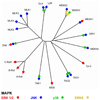The c-jun kinase/stress-activated pathway: regulation, function and role in human disease
- PMID: 17306896
- PMCID: PMC1995559
- DOI: 10.1016/j.bbamcr.2006.12.009
The c-jun kinase/stress-activated pathway: regulation, function and role in human disease
Abstract
c-Jun N-terminal kinases (JNKs), also referred to as stress-activated kinases (SAPKs), were initially characterized by their activation in response to cell stress such as UV irradiation. JNK/SAPKs have since been characterized to be involved in proliferation, apoptosis, motility, metabolism and DNA repair. Dysregulated JNK signaling is now believed to contribute to many diseases involving neurodegeneration, chronic inflammation, birth defects, cancer and ischemia/reperfusion injury. In this review, we present our current understanding of JNK regulation and their involvement in homeostasis and dysregulation in human disease.
Figures




References
-
- Derijard B, Hibi M, Wu IH, Barrett T, Su B, Deng T, Karin M, Davis RJ. JNK1: a protein kinase stimulated by UV light and Ha-Ras that binds and phosphorylates the c-Jun activation domain. Cell. 1994;76:1025–1037. - PubMed
-
- Smeal T, Binetruy B, Mercola DA, Birrer M, Karin M. Oncogenic and transcriptional cooperation with Ha-Ras requires phosphorylation of c-Jun on serines 63 and 73. Nature. 1991;354:494–496. - PubMed
-
- Kyriakis JM, Banerjee P, Nikolakaki E, Dai T, Rubie EA, Ahmad MF, Avruch J, Woodgett JR. The stress-activated protein kinase subfamily of c-Jun kinases. Nature. 1994;369:156–160. - PubMed
-
- Behrens A, Sibilia M, Wagner EF. Amino-terminal phosphorylation of c-Jun regulates stress-induced apoptosis and cellular proliferation. Nature genetics. 1999;21:326–329. - PubMed
Publication types
MeSH terms
Substances
Grants and funding
LinkOut - more resources
Full Text Sources
Other Literature Sources
Research Materials
Miscellaneous

